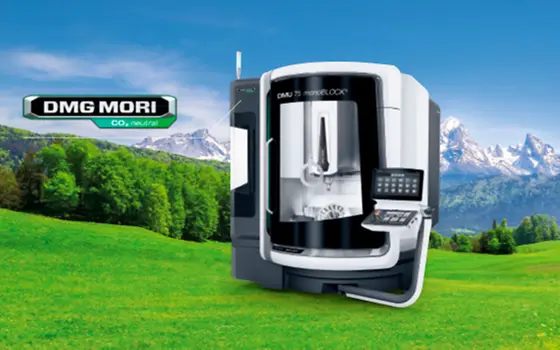DMG Mori: Pioneer for Sustainable Manufacturing Solutions
Ecological action and technology leadership do not have to be a contradiction.
Process integration, automation, digitization and sustainability: With holistic manufacturing solutions, DMG MORI takes global and holistic responsibility for resources along the entire value chain and across all scopes of the Greenhouse Gas Protocol: from product development and production of its own high-tech machines to sustainability-oriented cooperation with suppliers and the use of its unique manufacturing solutions by customers – also for manufacturing sustainability-related products.
On the way to climate neutrality
The comprehensive mission statement of DMG MORI GREEN ECONOMY with its three pillars shows how holistically DMG MORI has anchored sustainability in all structures and processes:
- GREENMACHINE for the resource-efficiently produced machine (Scope 1, 2 and 3 upstream),
- GREENMODE for resource-efficient machine operation at the customer’s site, and
- GREENTECH as a sign of the competence partnership in the development process of green technologies.
As an overarching result of its multiple initiatives, DMG MORI aims to reduce its Scope 1 & 2 emissions by 46.2 percent and Scope 3 emissions by at least 13.5 percent by 2030 (measured relative to 2019). To achieve these targets, the company avoids and reduces emissions throughout the entire manufacturing process and life cycle of the machine. The immediate focus here is on customer operations by sustainably improving the resource efficiency of DMG MORI machines via GREENMODE, while at the same time increasing productivity.
Pioneering competence partnership
Another stable pillar of the sustainability strategy is the competence partnership as part of the GREENTECH offensive. Worldwide, 16 DMG MORI Excellence Centers and the DMG MORI production plants support their customers in manufacturing products for projects related to sustainability: wind turbines, hydropower plants, hydrogen electrolysis or electromobility. With specific know-how, the experts there design innovative manufacturing solutions from the idea to the final workpiece.
Fascinating possibilities in all technologies
The portfolio of established metal-cutting technologies such as milling, turning, grinding, and ultrasonic on the one hand and future-oriented additive manufacturing on the other offers fascinating manufacturing solutions. Today, products can increasingly be manufactured with reduced weight, optimized functionality and minimal transport distances in a way that conserves resources. A common feature of all manufacturing solutions is the demand for maximum efficiency and effectiveness as well as task-optimized precision. The technologies achieve tolerances of up to 5 µm. This corresponds to the wall thickness of a soap bubble.
Tvar: Forged turbines for hydropower plants
With its production of high-quality turbine components for hydropower plants, Tvar is a good example of the numerous competence partnerships in the GREENTECH sector. Hydroelectric power generation has its origins in ancient times and the technology has been continuously developed into modern times. In 2007, CNC Tvar from Liberec in the Czech Republic started to contribute to more efficient and sustainable energy generation with its products. Today, the portfolio includes turbine wheels, impellers, but also molds and components for automotive engineering. “Today, turbines made of forged steel are the benchmark in terms of efficiency, durability and reliability,” explains Jan Richtárik, joint managing director of CNC Tvar with Tomáš Meruňka. Cast iron, he says, is now only used where high wear is to be expected due to sand in rivers or aggressive chemicals. In all other cases, the company relies on forged turbines.
According to Jan Richtárik, the challenge with forged turbines is much greater: “We machine these components from the solid.” This is precisely how CNC Tvar quickly earned its good reputation in the industry. Around 300 turbines are produced here every year. Pelton and Francis turbines account for 90 percent. In addition to the actual precision manufacturing, the company also offers balancing, certification and non-destructive testing of each turbine. “We supply turbines ready for assembly,” adds Tomáš Meruňka. CNC Tvar has been successful with this: in the Alps alone, 80 percent of hydropower plants are equipped with turbines from Liberec. In production, CNC Tvar has been using machine tools from DMG MORI from the very beginning – nine DMU 200 P and DMU 210 P, three DMU 340 P and one DMU 95 monoBLOCK.
NEHER GROUP: E-mobility with new challenges for tool design
Another example of GREENTECH is provided by the NEHER GROUP from Ostrach, Germany, which was founded in 1990. Here, 110 experienced specialists produce high-quality and precise PCD or CVD special tools increasingly for the electromobility sector. This is because precision machining of a stator housing – the housing in which the rotor of the electric motor rotates – requires comparatively long and thus usually heavy tools. “For numerous existing machine tools, as they are mostly used, the weight and the tilting moment of the tools is too high to change them in automatically. However, low-vibration and precise machining can only be ensured in some areas by means of such built-up tools,” Tobias Niess, who is responsible for the development of the tools, describes the challenge. The weight can be reduced in two ways: “By using lighter materials, such as titanium, and by finding new ways in design and, above all, with the help of DMG MORI’s innovative manufacturing technologies.”
One of these technologies is additive manufacturing. For the production of tool bodies, NEHER GROUP uses powder bed technology from DMG MORI – a LASERTEC 30 SLM and a LASERTEC 30 DUAL SLM. “The layer-by-layer buildup takes place directly on a previously milled interface,” says Tobias Niess. Additive manufacturing allows absolute freedom in design, he adds. “On the one hand, we can integrate cooling channels close to the contour, which contribute to the durability of the tool. On the other hand, we can realize bionic structures inside the tools using the finite element method, which ensure maximum stability and optimal vibration behavior.” Compared to conventional tools, the weight saving is also between 30 and 70 percent, he adds.
This content was first published on the DMG Mori website.

